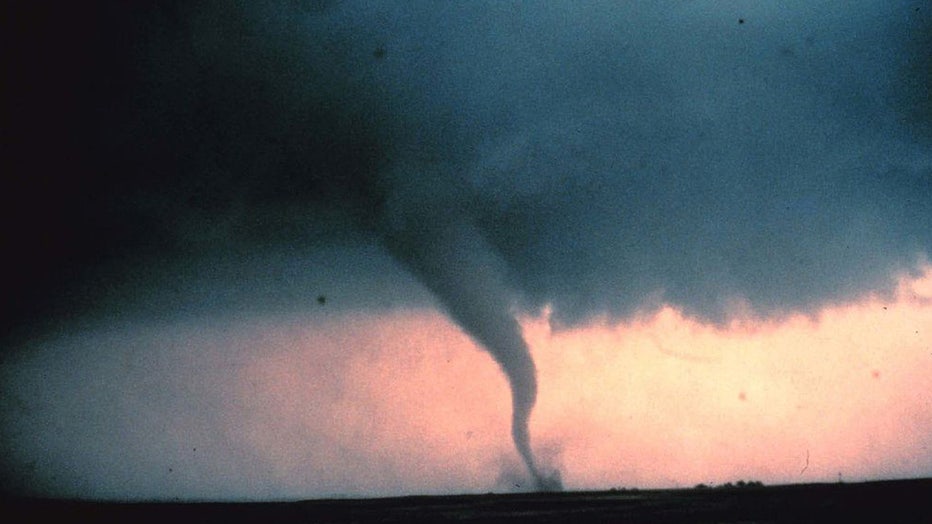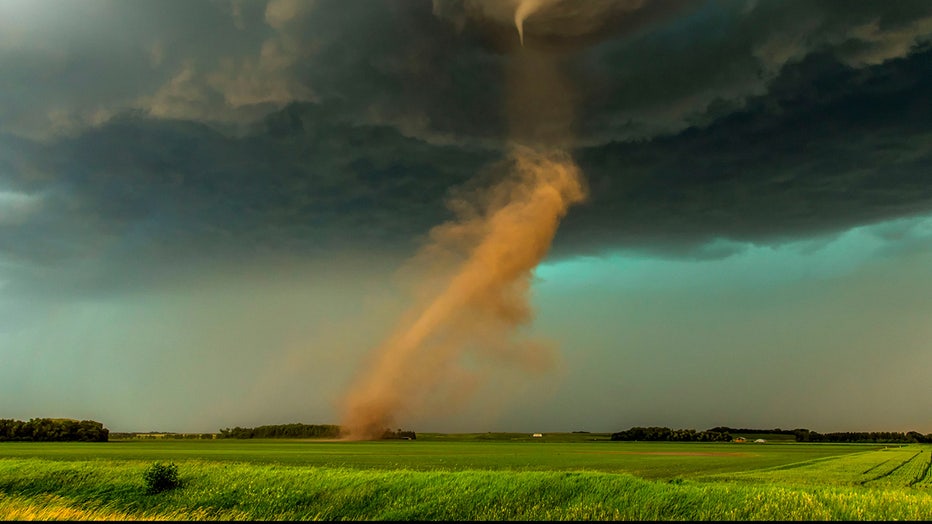Why does the US have the most tornadoes?
Tornadoes are more common in the US compared to the rest of the world: Expert explains
Dr. Harold Brooks, senior research scientist at the NOAA’s National Severe Storms Laboratory in Oklahoma, spoke with FOX TV Stations to explain why the United States is in the "perfect spot" to supply all the necessary ingredients for a tornado to form.
Tornadoes are some of the most destructive and mesmerizing weather phenomena on this planet and scientists are still learning more about them to this day, including how often they occur and where.
Some places are more likely to experience these violent rotating columns of air than others.
The United States has had the most tornadoes than any other country in recorded history, according to the National Oceanic and Atmospheric Administration’s (NOAA) Storm Prediction Center.
On average, the U.S. has about 1,200 tornadoes hit every year, which is a sizable difference compared to other areas of the world such as New Zealand, which only reports about 20 tornadoes a year.
These averages, however, are only rough estimates as the method of recording tornadoes is always changing and it’s a difficult task, according to Dr. Harold Brooks, senior research scientist at the NOAA’s National Severe Storms Laboratory in Oklahoma.
"Our records are incomplete almost everywhere. And in large part that's because you have to have someone observe the event, and you have to have a system that collects those reports and actually archives them," Brooks said.

FILE - View of the 'rope' or decay stage of tornado seen during 'Sound Chase,' a joint project of NSSL and Mississippi State University in Cordell, Oklahoma May 22, 1981. (NOAA Photo Library/Getty Images)
Location is key
"When we look at the map of the United States, we see that it's relatively easy to bring the ingredients together to make tornadoes," Brooks told FOX TV Stations.
Tornadoes need warm, moist air to form and the U.S. just so happens to have a steady supply of this ingredient, which comes from the Gulf of Mexico.
Tornadoes also need cool, dry air which the U.S. gets from the Rocky Mountains.
"The fact that we have the Rocky Mountains and the Gulf of Mexico located where they are, means that it’s relatively easy to get the ingredients to come together to make tornadic storms in the middle part of the U.S.," Brooks said.
When is tornado season in the US?
Typically, tornado season in the U.S. occurs during different times of the year depending on where you live in the country.
For the southern Plains (which includes Texas, Oklahoma and Kansas), tornado season begins around May and into early June, according to the NOAA National Severe Storm Laboratory (NSSL).
For those who live closer to the Gulf coast, it’s earlier in spring.
Areas in the northern Plains and upper Midwest (which includes North and South Dakota, Nebraska, Iowa, and Minnesota, tornado season is in June or July.
States with the most and least tornadoes
In 2023, the NOAA identified 1,341 tornadoes in the U.S. and about 31% of those occurred in three states: Mississippi, Alabama and Texas, according to the USA Facts website.
All three of these states reside on the Gulf Coast and are part of "Dixie Alley," which is different from "Tornado Alley."
"Dixie Alley" refers to the tornado-prone area in the Southeastern U.S.
Mississippi has had the most tornadoes over the last five years, averaging 115 per year. Texas came in second with an average of 96 per year and next was Alabama with an average of 90.
Where is tornado alley?
There is no scientific designation for Tornado Alley, but most people are referring to a stretch from the Great Plains to the Midwest. Where the highest number of average tornadoes per year happen – the Central and Southern Plains – is the heart of the Alley.
The term was coined by two Air Force Weather Officers, according to NOAA. On March 20, 1948, a tornado roared across Tinker Air Force Base near Norman, Oklahoma. Airplanes were flipped over, airmen were injured and power lines were downed. Maj. Ernest Fawbush and Capt. Robert Miller said they had no warning.
On March 25, 1948, Fawbush and Miller noticed similar atmospheric conditions to the 20th and put out the first official tornado forecast. It was verified when another tornado hit the base, and tornado forecasting was born in the U.S.
The duo set up a project called "Tornado Alley" to study severe weather from Lubbock, Texas, to Eastern Colorado to Nebraska.
Top 10 deadliest tornadoes in the US
- Death toll: 695 Tri-state (Missouri, Illinois, Indiana) March 18, 1925
- Tri-state (Missouri, Illinois, Indiana)
- March 18, 1925
- Death toll: 317 Natchez, Mississippi May 6, 1840
- Natchez, Mississippi
- May 6, 1840
- Death toll: 255 St. Louis, Missouri May 27, 1896
- St. Louis, Missouri
- May 27, 1896
- Death toll: 216 Tupelo, Mississippi April 5, 1936
- Tupelo, Mississippi
- April 5, 1936
- Death toll: 203 Gainesville, Georgia April 6, 1936
- Gainesville, Georgia
- April 6, 1936
- Death toll: 181 Woodward, Oklahoma April 9, 1947
- Woodward, Oklahoma
- April 9, 1947
- Death toll: 158 Joplin, Missouri May 22, 2011
- Joplin, Missouri
- May 22, 2011
- Death toll: 143 Amite LA, Purvis Mississippi April 24, 1908
- Amite LA, Purvis Mississippi
- April 24, 1908
- Death toll: 117 New Richmond, Wisconsin June 12, 1899
- New Richmond, Wisconsin
- June 12, 1899
- Death toll: 116 Flint, Michigan June 8, 1953
- Flint, Michigan
- June 8, 1953

A tornado outbreak struck eastern North Dakota on June 27, 2015. (NOAA NWS, Amanda L. Hill)
Where else in the world do tornadoes occur?
Tornadoes can crop up anywhere in the world, but there are specific places that have better conditions for them to form than others.
Tornadoes typically come after a thunderstorm, so that’s the first thing that needs to occur.
Next, warm, moist air near the ground needs to mix with cooler, dry air from above by way of wind shear, which is a change in wind speed and/or direction with height, according to the National Weather Service.
Outside of the U.S., other parts of the world that also get tornadoes more frequently are some areas in South America.
Southern Brazil and northern Argentina tend to get more reports of tornadoes than their neighbors, according to Brooks.
The Andes Mountains provide the cold, dry air and the Amazon rainforest supplies the warm moisture, but the conditions aren’t nearly as ideal as those in the U.S.
"We look at Europe, the Alps are basically an East-West barrier of mountains. So, it's a little bit harder to bring in that cool, dry air aloft. And it's the same thing we see when we look around the Himalayas. So Bangladesh, when they bring the ingredients together, gets some tremendously violent tornadoes and thunderstorms. But it's really hard because you have to have the winds aloft blowing basically out of the north to bring things together. And the same thing, over South China, which is another place that gets a reasonable number of storms, is the air tends to go around the Himalayas rather than over the Himalayas. And that limits how cool and dry the air can be," Brooks explained.
Is climate change impacting the frequency or intensity of tornadoes in the US?
There’s no clear evidence of that, according to Brooks. While global warming may be a reason for more intense storms, it’s hard to say whether it is impacting the intensity or frequency of tornadoes, specifically.
"It’s hard to detect a climate change signal on tornadoes and severe thunderstorm occurrences in the U.S. and in large part that’s due to a couple of things. One is the fact that we have this favorable geography, the Rockies and the Gulf of Mexico, those are really big drivers of the system," Brooks said.
In places such as Europe, detecting whether something is evolving due to climate change is easier and one example of this is hail storms.
"We've got pretty good evidence that the energy available for storms has increased. And again, it's a lot easier to see in other parts of the world. And in Europe, there's pretty strong signals that the large hail has increased, and the frequency of the environments support that. In the U.S., It's just a lot harder to tell," Brooks continued.
FOX Weather contributed to this report. This story was reported from Los Angeles.

